Content Type
Profiles
Forums
Events
Posts posted by wimb
-
-
Update VHD_WIMBOOT Version 4.0
Download: from GitHub VHD_WIMBOOT-40 and Win_Reduce_Trusted-40 to make Mini 7/8/10 x64 in VHD with UsedSize about 2 GB
Manual: VHD_WIMBOOT.pdf
- Modified base_winsxs_2.cmd of cdob so that hardlinks are created for \Windows\WinSxS\*_microsoft-windows-servicingstack*
sevicingstack is needed for support of Adding Drivers by means of Dism.exe
- Add Drivers 7/8/10 in Offline Windows by using Dism.exe - Not suitable to Install SVBus Driver for booting from RAMDISK
Boot in MBR mode for Install of SVBus driver - use R-mouse menu to Run as admin file instx64.exe of SVBus bin folder- Update USB 7/8 Fix - Scan Offline Registry for USB3 Services as listed in file makebt\USB_78_Tweaks\Win78_USB3_Boot.ini
When Service for Installed USB3 driver is found then make USB Controller Service setting Start=0 and BootFlags=4 and Group=System Bus Extender
In this way more hardware is supported for booting Win 7/8 VHD from USBMore Info on booting Win7/8 from USB given by cdob and info on how to get USB3 drivers

 0
0 -
Good to start here at MSFN discussion about grub4dos for UEFI.
The English download location for latest grub4dos-0.4.6a_for_UEFI-2020-11-26.7z is found at GitHub grub4dos Releases
0 -
Update VHD_WIMBOOT Version 3.7
Download: from GitHub VHD_WIMBOOT-37 and Win_Reduce_Trusted-37
- USB Fix 7/8 - registry tweak Win7 and UsbBootWatcher.conf for USB Boot Updated
- Added Service Settings - Intel iusb3xhc and iusb3hub and ASMedia XHCI asmtxhci and asmthub3 - Start=0 and BootFlags=4 and Group=System Bus ExtenderUsbBootWatcher is useful also when booting from USB on other hardware to have the right USB service settings for that case.
Win_Reduce_Trusted allows to modify Offline Windows 7/8/10 in VHD - General Post Install Modifications
- Reduce UsedSize in VHD to about 2 GB
- make Mini 7/8/10 x64 in VHD booting as FILEDISK from USB / SSD and booting from RAMSDISK using SVBus driver
- Add Folders and Files and Registry Tweaks - e.g. Add FirewallAppBlocker and SwiftSearch
- USB Fix 7/8 for booting 7/8 VHD from USB
- run Custom Command for post install modifications1 -
On 11/20/2020 at 4:03 PM, wimb said:
WinNTSetup method Enable native USB Boot of Windows 7 is working great for direct Install of Win7x64 in VHD on USB.
WinNTSetup Enable USB Boot of Windows 7 was successful for me,
but it was so because by luck I connected the USB SSD to the port for which WinNTSetup made the essential corrections of the USB extended host controller.
In my case WinNTSetup changed the Intel iusb3xhc and iusb3hub such that Start=0 and BootFlags=4 and Group=System Bus Extender, which is working OK.
But when I connect the USB to other port that has ASMedia XHCI as controller, then WinNTSetup results in USB Boot failure.
In that case WinNTSetup changes the same Intel iusb3xhc and iusb3hub Service Settings, whereas it would be needed to correct asmtxhci and asmthub3 Service settings.My original USB Boot problem for 7x64 Compact VHD can be solved also by adding the correct USB Service settings after Apply as done in VHD_WIMBOOT.
In my case it means that Intel iusb3xhc and iusb3hub and ASMedia XHCI asmtxhci and asmthub3 Service settings must have Start=0 and BootFlags=4 and Group=System Bus Extender.
These settings were missing in my original USB Fix from 2013, which explains why I had this USB Boot failure.
After adding these corrections to my USB Fix then everything is working OK.
Also the ASMedia XHCI Services asmtxhci and asmthub3 can be added to Tools\Win7USBBoot.ini so that WinNTSetup will also be OK for both cases Intel and ASMedia XHCI1 -
6 hours ago, alacran said:
Maybe you should try making the first 7 installation (using a VHD native bootable version) on a VHD located on a USB device, as long as the VHD and the Boot files/folders will be on a USB device, then WinNTSetup will take care to make all required modifications to load the USB drivers on appropiate timing, (this is based on cdob old commands [valid for USB 2.0 and USB 3.0 if available] made long time ago), You will see on WinNTSetup the option for Enable Native USB Boot on Windows 7 on the very last window just before starting to install, see attached picture, but this will be present only if installing on a USB device, if doing the installation this way USB boot watcher is not necessary.
WimBootCompress.zip 1.15 kB · 1 download diskmod.zip 45.29 kB · 1 download
WinNTSetup method Enable native USB Boot of Windows 7 is working great for direct Install of Win7x64 in VHD on USB.
After using VHD_WIMBOOT wimlib for Capture and Apply in Compact LZX mode and using Win_Reduce_Trusted then VHD is still booting OK from USB
Win7x64 Compact LZX in 3.9 GB VHD has UsedSize = 1.82 GB with LZX WIM = 1.23 GB
0 -
Update VHD_WIMBOOT Version 3.6
Download and Manual: VHD_WIMBOOT
- registry tweak Win8 and UsbBootWatcher.conf for USB Updated - Added Services USBXHCI UCX01000 iusb3adp UASPStor - "Group"="Boot Bus Extender" and Start=0
- added diskmod.zip filter driver to see all USB removable drives as fixed disks
Thanks for diskmod filter driver to see all USB removable drives as fixed disks, which has been added to VHD_WIMBOOT-36
Thanks also for advice to use WinNTSetup option Enable native USB Boot on Windows 7, which I will try to see if Compact LZX Win 7x64 can boot from USBMy problem with Win 8x64 for booting as FILEDISK from USB is solved - essential USB Services did not have Start=0 and were not Boot Bus Extender
Also Win8.1x64 Compact LZX VHD is booting now fine from USB as FILEDISK as shown for a Win_Reduced version.1 -
1 hour ago, alacran said:
Why? Is it a restriction coded into the program?
I have an old 8.1 x64 Compact Mode 8K VHD (made with your old Mini8 program) and it boots fine as Filedisk.
It is not a restriction in the program. The program allows to make Win 7/8 x64 Compact VHD.
Does your 8.1 x64 Compact VHD boot as FILEDISK when located and booting from USB ?
In my case Win 7 / 8 x64 Compact LZX VHD are booting fine as FILEDISK when located on internal harddisk,
but booting fails when such 7/8 Compact VHD is located and booting from USB.
Win 7x64 Applied in Normal mode VHD is bootable for me from USB.
I think for 7/8 Compact there are more uncompressed files needed for booting from USB as compared to the prepoluted files as specified in WimBootCompress.ini7/8 x64 Compact LZX VHD is booting fine from RAMDISK also when the VHD was loaded from USB into RAMDISK.
0 -
Update VHD_WIMBOOT Version 3.5
Download and Manual: VHD_WIMBOOT
- Option Keep VHD Mounted after Apply, which is useful e.g. if you want to continue and use Win_Reduce_Trusted on Mounted VHD
- Option USB Fix for Windows 7 / 8 - Add UsbBootWatcher and Update Registry for booting Windows 7 / 8 VHD from USBWin 7/8 Compact requires to install wofadk.sys driver as done by WinNTSetup using mode Compact:NONE
More Info on Win 7/8 Reduced
EDIT: Win7x64 and Win8.1x64 Compact LZX in VHD are bootable from USB, so there is no need anymore to Apply Normal Mode
 1
1 -
Mini_10x64.vhd is booting as FILEDISK from USB in UEFI Secure and in MBR BIOS Legacy mode
also when located on Ventoy NTFS drive using ventoy_vhdboot.img
VHD of 3.9 GB has UsedSize = 1.75 GB
0 -
Update Download: Win_Reduce_Trusted-36
I have removed the file imdiskinst.exe which was giving the false positive warning at Yandex Disk
0 -
Update Download: Win_Reduce_Trusted-36 and VHD_WIMBOOT
Manual: VHD_WIMBOOT.pdf
Win_Reduce_Trusted-36 is suitable to Reduce Windows 7/8/10 x64
to make Mini 7/8/10 x64 in VHD with UsedSize about 2 GB whch can be used for booting from RAMDISK or as FILEDISK
Win 7/8 requires to install wofadk.sys driver as done by WinNTSetup using mode Compact:NONE
More Info on Mini 7/8 x64 in VHD
 0
0 -
Update Download: Win_Reduce_Trusted-36
In folder Win_reduce\Add_to_UserPath the Desktop and SendTo Links for using LibreOfficePortable and VLC and PStart are given
And folder Documents contains the required Utilities for using external drive with Programs as Drive Y: comparable as done in Win10XPE
Win_Reduce_Trusted will auto add these items when Add Folders and Files checkbox is SelectedThe folder Add_to_USB_Y is not used by the program, but contains the Structure that is expected at the external Drive that gets Drive Letter Y:
It is required to Manually copy the tagfile CDUsb.y to your external Programs Drive
The CDUsb.y tag when found is used by Set Drive-Y Link on Desktop to Set External Drive as Drive Y:
Also you can Manually Add PStart as given and VLC and LibreOfficePortable and other Programs to your external Drive e.g. USB-DrivePortable VLC 64-bits - Download vlc-3.0.11-win64.7z from http://ftp.videolan.org/vlc/3.0.11/win64/
Copy the content of vlc-3.0.11 to VLC folder on external Programs DriveDownload LibreOfficePortable from https://www.libreoffice.org/download/portable-versions/
More Portable Apps
https://portableapps.com/apps/office/libreoffice_portable
https://www.portablefreeware.com/index.php?id=599
More Info: Reducing Win10 and older OSs footprint
0 -
VHD_WIMBOOT has RAMDISK Option to Create Dynamically Expanding VHD files which are useful for fast loading into RAM
Sparse files are less compatible for booting as VHD and can loose sparse attribute on copy.
To boot VHD as FILEDISK you can simply use the Captured WimBoot LZX WIM file to Apply in Compact LZX mode on New Created Fixed VHD of Size 3.9 GB
Fixed VHD has the advantage that it does not result in fragmentation of the VHD file when more internal space is used.
3. Mount VHD with doubble-click and use Win_Reduce_Trusted on Offline Windows
- Reduce in 30 seconds gives Mini 10x64 VHD UsedSize = 1.79 GB
- Capture WimBoot LZX WIM = 1.19 GB and Apply Compact LZX in 3.9 GB VHD0 -
2 hours ago, sharicov@gmail.com said:
Couple of questions:
1. Do I need both wim and VHD files to boot?
2. VHD used size is 6.97GB while vhd file takes 25GB on disk, or 11GB when compressed with NTFS. I shrunk it with disk manager to 7GB but the rest empty space in VHD is not reflected in VHD size, which is still 25GB. How can I make the vhd size to be 7GB?
Thanks in advance
Apply WIM in Compact LZX mode gives VHD that boots independent of WIM
Apply WIM in WimBoot mode gives VHD with pointers to the non variable files in the WIM archive. VHD and WIM are coupled and both needed to boot.Did you Apply WIM in Compact LZX mode in case of your final result with Used Size 907 MB ?
What is the Size of your WIM file ? You used Virtual Box for that case ?After Win_Reduce_Trusted then the Captured WimBoot LZX WIM file is very small e.g. WIM Size = 1.19 GB
Then you can Apply WIM in Compact LZX mode in new Expandable VHD size 3.9 GB suitable for booting Mini10x64 VHD from RAMDISK without needing WIM file.
Booting from RAMDISK requires in advance to Install special SVBus driver and booting from RAMDISK is in MBR mode only using Grub4dos Menu.More Info: VHD_WIMBOOT.pdf
0 -
The WIM file is an install.wim file suitable for Apply and is not a bootable WIM file like boot.wim of Win10XPE
Also for making Mini10x64.vhd remember to follow:
1. WinNTSetup - Fresh Install in 25 GB VHD using Win10x64 ISO from TechBench
2. VHD_WIMBOOT - Capture WimBoot LZX and Apply in Compact LZX mode in VHD
3. Mount VHD with doubble-click and use Win_Reduce_Trusted on Offline Windows
- Reduce in 30 seconds gives Mini 10x64 VHD UsedSize = 1.79 GB
- Capture WimBoot LZX WIM = 1.19 GB and Apply Compact LZX in 3.9 GB VHD
4. Boot with 3.9 GB VHD - Always use the supplied Firewall App Blocker and Enable WhiteList to Allow Internet Browser only
- This is the easiest way to block unwanted internet traffic including Windows Update and prevents the growth of Used Size inside VHDYou have finished now Step 1 and 2
Now it is time for Step 3 and 4
0 -
Yes it is all normal.
It is not needed to make Boot entries again, since they were made already earlier for your VHD. So answer No is OK.
The Format Dialog is needed since you want Apply WIM file on clean VHD (it corresponds to Install of Windows).
So Start Format and then Close.
Succes .... I think it is normal and good that you are a bit concerned at this point.
0 -
1 hour ago, sharicov@gmail.com said:
VHD is mounted because I am booting from it...
Or should I just boot from it for user folder to be created and then go back to the mastering environment? Nor clear to me from the manual:
2. Boot with Win10XPE Or other Win10x64 and Switch off Defender - Start VHD_WIMBOOT - select System Drive and the 25 GB VHD file.
Please clarify the flow
To me Step 2. is quite clear described - Just do it
You boot from VHD to Install Win10x64 in VHD and indeed then your User folder is created - Finally Shutdown
Boot Win10XPE Or other Win10x64 means that you are not anymore in VHD running Win10x64
For VHD_WIMBOOT the Windows to be Captured must be offline, so you just select the VHD file
0 -
In VHD_WIMBOOT the VHD must NOT be mounted in advance
(it is nowhere mentioned to mount the VHD in advance of using VHD_WIMBOOT)

Use Windows Explorer to Eject the mounted VHD Drive.
Then Start VHD_WIMBOOT and continue the procedure ....
Where is Drive D: located ?
0 -
20 minutes ago, sharicov@gmail.com said:
Redoing everything from scratch.
After WinNTSetup installation getting error BFSVC 0x70.(probably boot partition is too small (default windows installation)
PFA Host disk layout and the error message.
System Reserved Hidden Boot Partition Size is far too small, only 50 MB with free space 2 MB

Increase Size of Boot partition to 300 MB
You can use AOMEI Partition Manager in Win10XPE environment Win10_Install.pdf
0 -
1 hour ago, sharicov@gmail.com said:
I don't understand how do I do it.
In the manual it says: 2. Boot with Win10XPE Or other Win10x64 and Switch off Defender - Start VHD WIMBOOT - select System Dive and the 25 GB VHD file.
Not clear to me. Also I am working out of Virtualbox. Is there a way to boot from VHD without USB drive?
Don't use Virtualbox, it is nowhere stated to do so ....
Before Step 2. you need to do Step 1.
1. WinNTSetup do Fresh Install Compact 4K mode of Win10x64 in 25 GB VHD located on Internal System Drive C: - use page 2 of this Manual
Create the VHD in root of your normal Win10x64 drive C: e.g. VHD is C:\Win10x64.vhd
Yes you can boot from internal SSD with VHD created next to your normal operating system. You get Windows Boot Manager multiboot menu.
0 -
WinNTSetup will auto mount boot partition as Drive Z:
So can you boot now with VHD to Install Windows 10x64 in VHD ?
0 -
9 hours ago, sharicov@gmail.com said:
I have mapped EFI partition as A:
And yes, you are right, I didn't reboot, couldn't figure out the way to boot from VHD file.
Nowhere in the Manual is stated that you should mount Boot partition as A:
You must not mount Boot partition.
WinNTSetup will auto mount the Boot partition as Z:
WinNTSetup will auto mount created VHD as Drive Y:
0 -
You don't have EFI partition since you are booting in MBR mode with \bootmgr and \Boot\BCD
In WinNTSetup use upper-right icon to launch BOOTICE to inspect BCD of current system in Professional mode
There must be at least two boot entries: your Windows and the VHD - Give Screenshot of BOOTICE showing BCD Menu entries
Take care that all menu entries have BootMenuPolicy = Legacy and that Windows Boot Manager Timeout = 30 seconds
0 -
I understand now the mistake that you made: you never installed Windows
After WinNTSetup Setup then you need to Reboot for the Installation of Windows so that also Users\Your_User_Name folder is created.
Strange that you have Selected A: as Boot drive. Is A: the Floppy Disk Drive ? Select your normal Boot Drive.
Reboot means Shutdown computer and Start computer for Install of Windows in VHD
 0
0



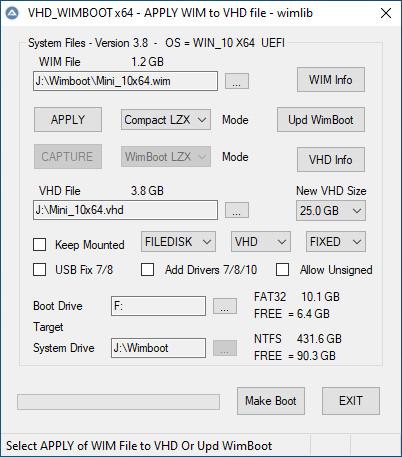
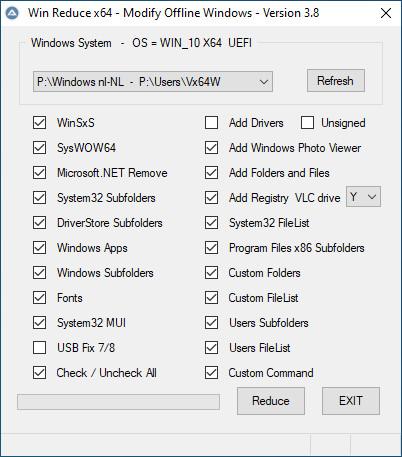
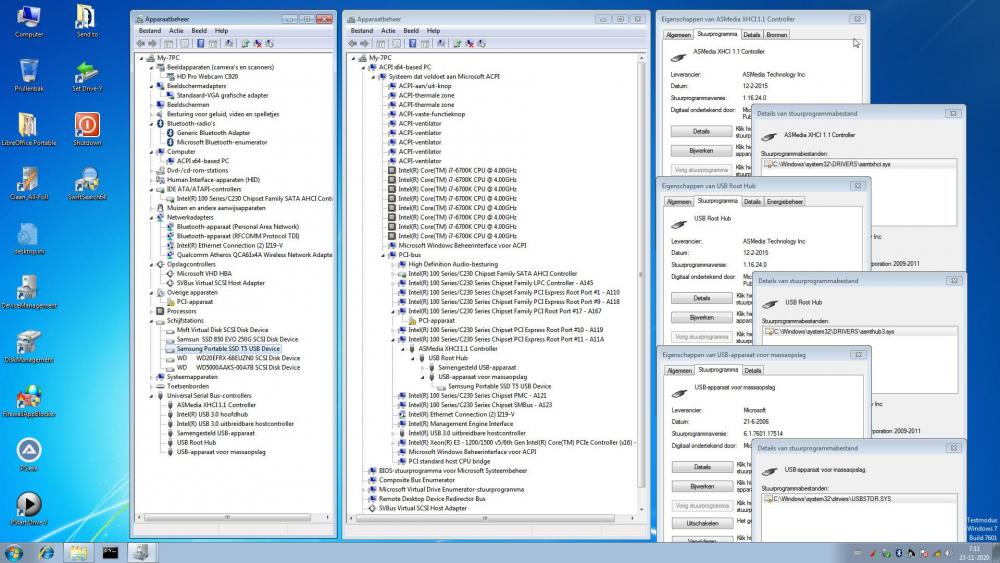
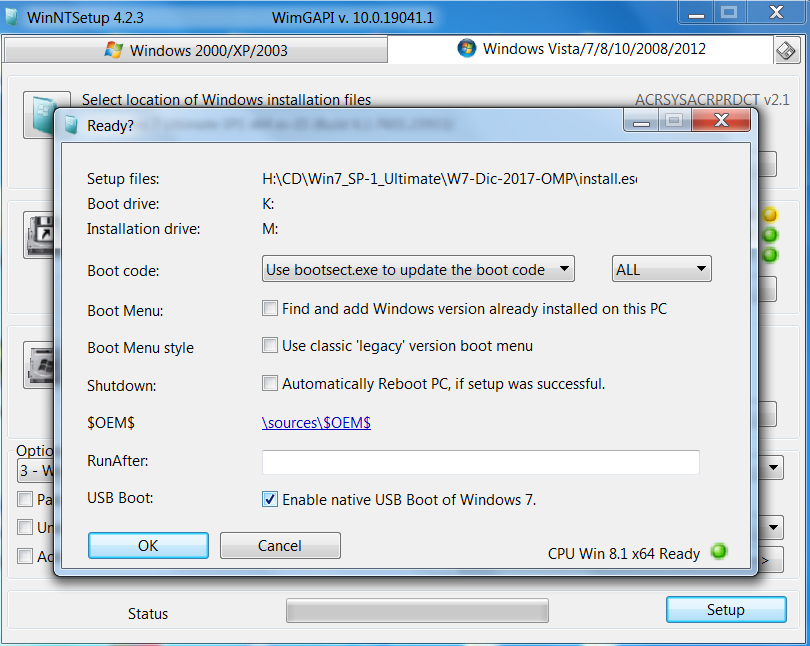
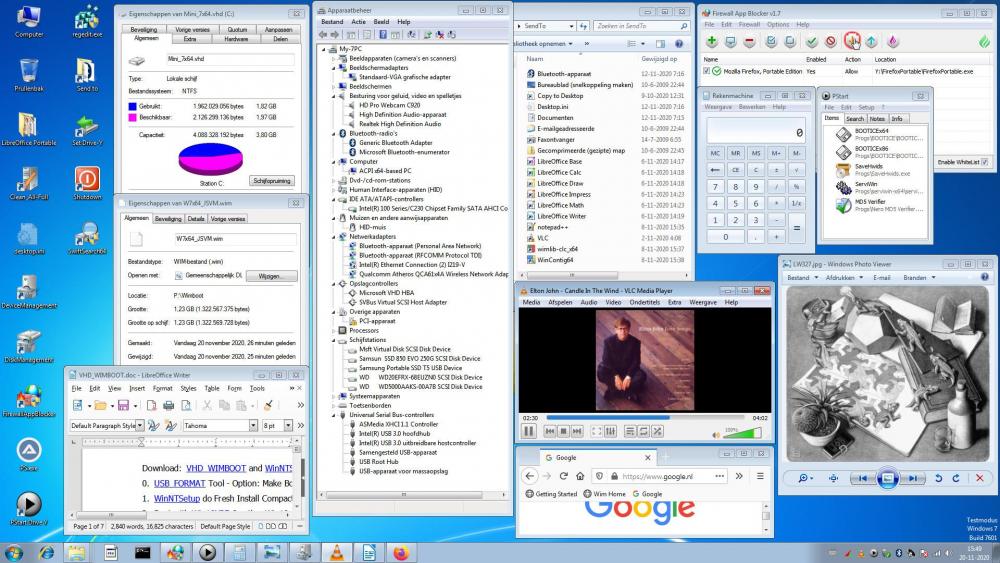
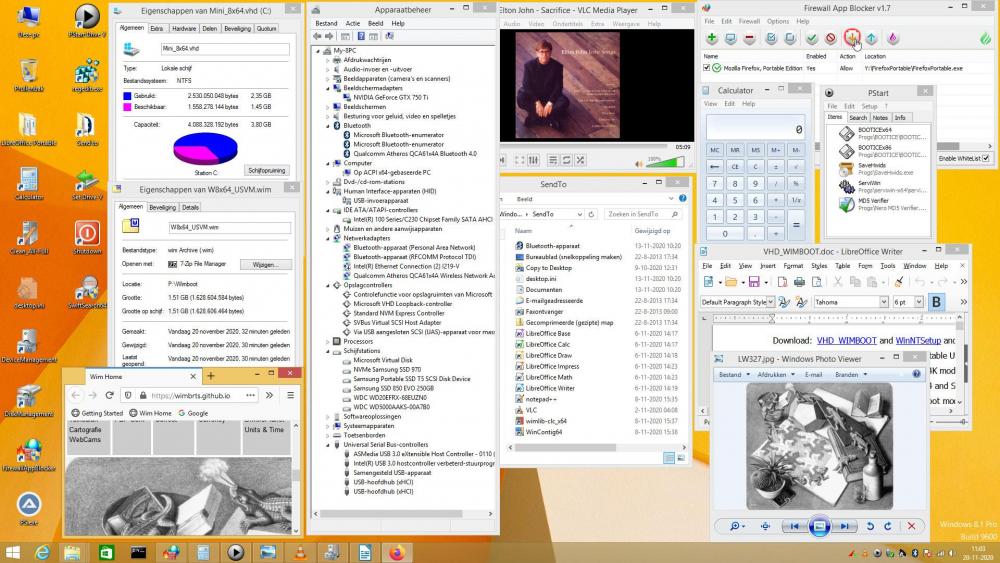
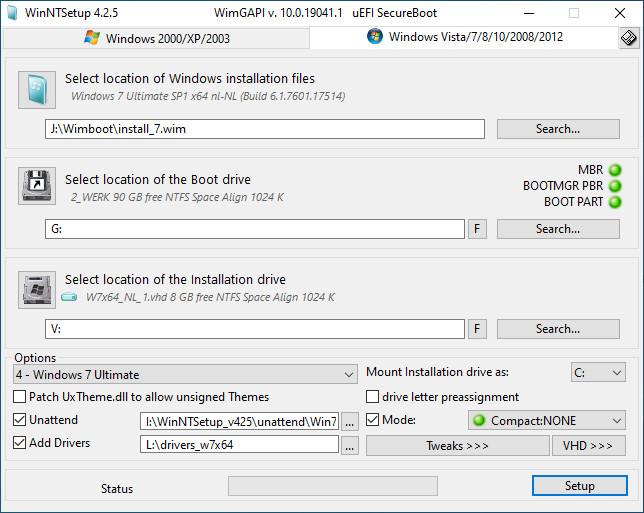
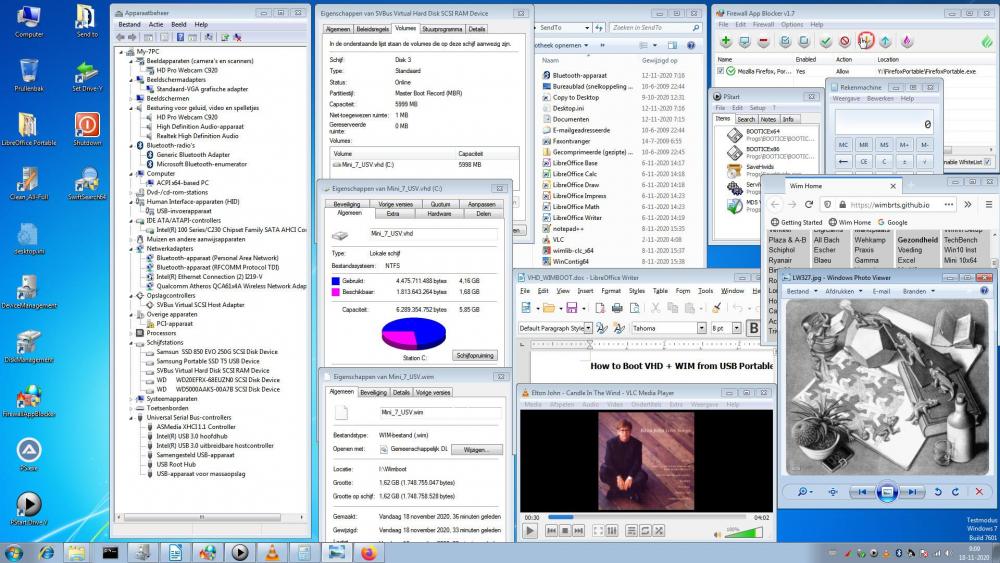
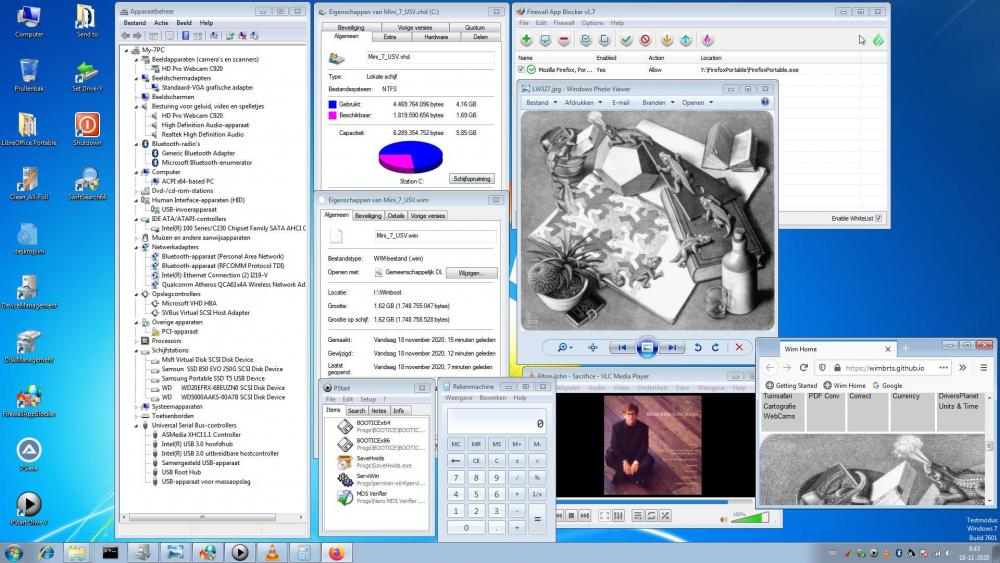
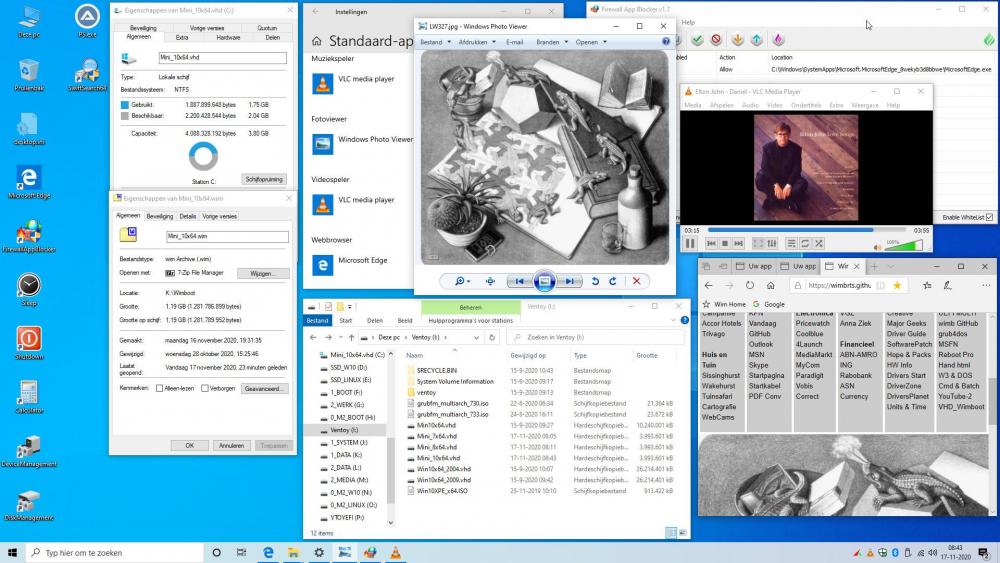
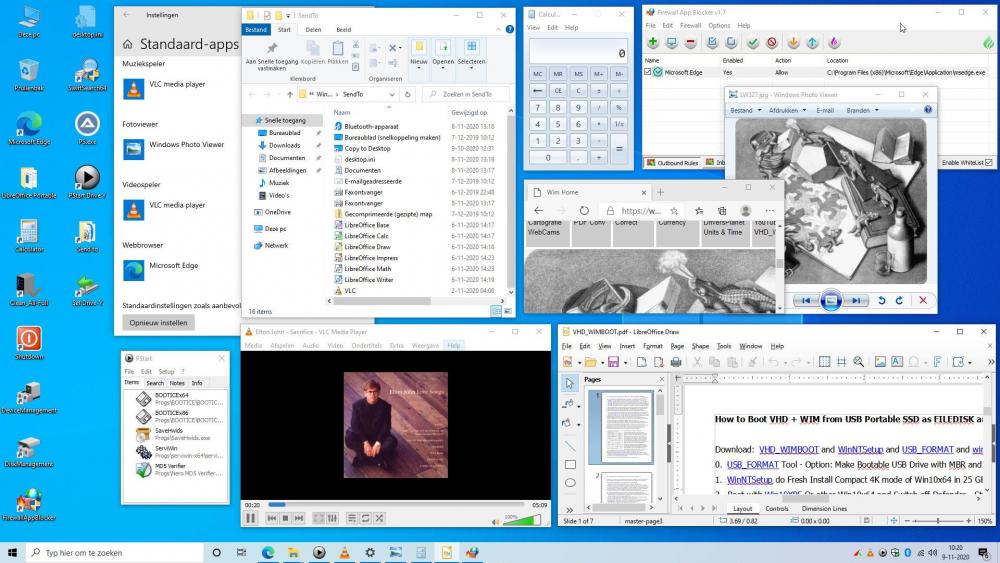
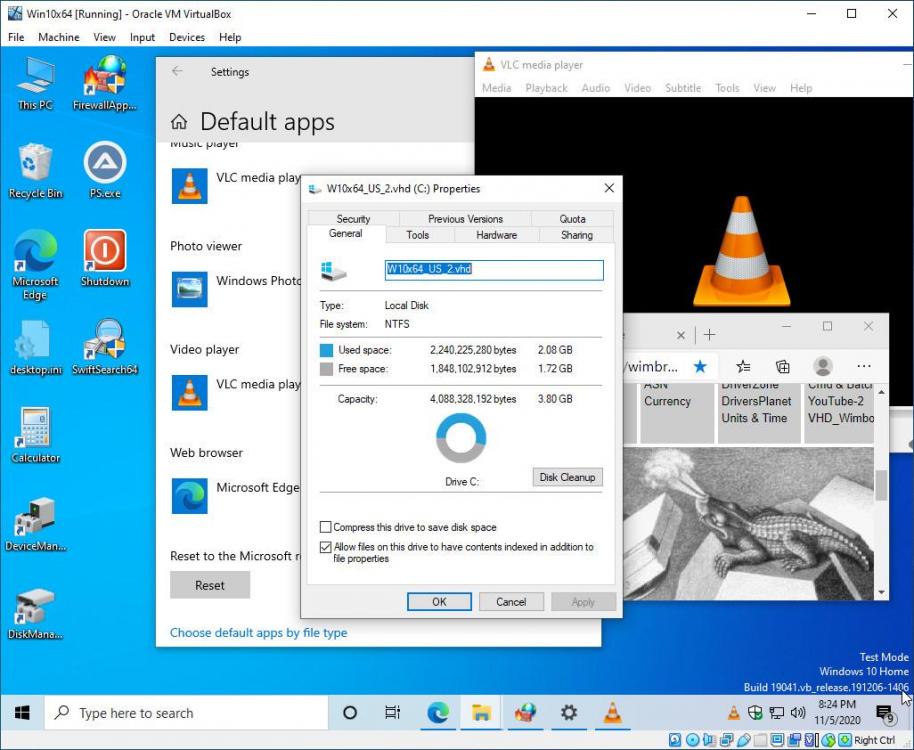
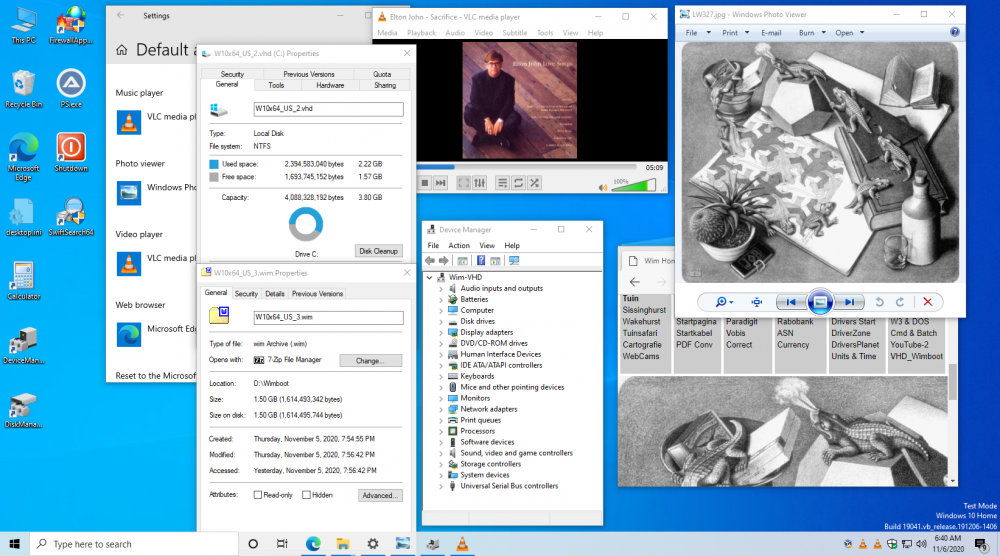
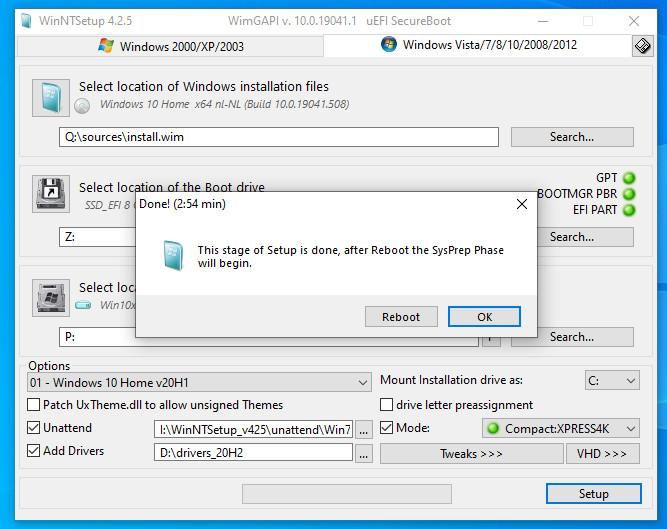
grub4dos for UEFI
in Install Windows from USB
Posted · Edited by wimb
New from a1ive UEFI Grub2 that can be used for booting Mini10 VHD from RAMDISK.
Download: latest Grub2 of a1ive has support for svbus
More Info: UEFI Grub2 at reboot.pro in Grub4dos for UEFI topic
In Admin Command Window use Diskpart to make VHD which needs to have MBR and 2 partitions - 100 MB FAT32 + rest NTFS
create vdisk file="D:\VHD\Mini10_SV.vhd" maximum=3900 type=fixed select vdisk file="D:\VHD\Mini10_SV.vhd" attach vdisk create partition primary size=100 format quick fs=fat32 label="EFI_VHD1" assign active create partition primary format quick fs=ntfs label="Mini10_SV_VHD2" assign list vol exitSigned SVBus driver from a1ive is needed to allow using grub.cfg menuentry - Password=reboot.pro
otherwise grub2 commands must be used and allow unsigned SVBus driver by F8 menu
UEFI grubx64.efi located in EFI\Boot expects as configfile \boot\grub\grub.cfg
EFI\Boot folder according to UEFI_MULTI-50 with UEFI_MAN\efi\Boot where grubx64_real.efi is replaced by new a1ive UEFI Grub2 file
Grub2 command to get menu
configfile /boot/grub/grub.cfgGrub2 menuentry in grub.cfg
menuentry "Mini10_SV.vhd from RAMDISK" { map --mem --rt (hd0,gpt2)/VHD/Mini10_SV.vhd boot }